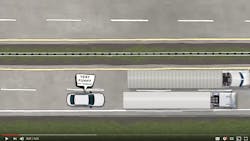Speed limiters, elephant races, and professional drivers
Despite the Trump administration’s putting the brakes on federal rulemaking, the Owner-Operator Independent Drivers Association is ramping up its own regulatory push back: The small business trucking group has created a video demonstrating the dangers of speed-limited trucks. But are speed limiters really the issue? At least one veteran professional driver doesn’t think so (although speed limiters could well make a longtime problem worse). Better driver training and "common courtesy" are the real solutions to the problems caused by big rigs driving side by side on the freeways.
A mandate to limit the speed of large trucks was proposed by the Federal Motor Carrier Safety Administration and the National Highway Transportation Safety Administration last September. The association has opposed the mandate and argues such devices create congestion and speed differentials, which lead to higher accident involvement rates.
“Studies and research have already proven what we were all taught long ago in driver’s ed classes, that traffic is safest when vehicles all travel at the same relative speed,” says Norita Taylor, director of public relations at OOIDA. “Limiting trucks to speeds less than the flow of traffic increases interactions between vehicles which can lead to more crashes.”
The video demonstrates in animated format along with infographics what happens to traffic when trucks are speed limited, most notably the unsafe driving of four-wheelers around slower trucks. It also includes a short interview with Dr. Steven Johnson, a researcher that has conducted extensive empirical studies on highways and speed. This one page fact sheet from OOIDA has more statistics and information on speed limiters.
Tommy Wade, who’s been driving over-the-road since 1978, confirms that impatient four-wheelers do indeed behave as shown in the OOIDA video, and people do seem to be increasingly impatient. But the issues of speed differentials and “elephant races” have been around since well before all trucks were equipped with optionally set speed limiters, he suggests.
“It doesn’t matter if we have speed limiters or not, you’re going to have the same problem. That speed limiter is not driving that truck,” says Wade, who drives for a private fleet. “If they’re professional drivers, they will get out of that situation when it arises. I have seen drivers at 72 MPH get beside each other and they both hang out there. A speed limiter is not the cause.”
More trucks, and more traffic in general, have made the problem worse over the years, he suggests. And while some faster truck drivers have always caused problems by staying in the left lane on uphill grades, there are clearly more drivers running side by side on the flats stretches now.
He makes clear, however, that industry does not need a speed limiter mandate, nor does he want one. Wade insists he’d continue to drive 65 MPH as he has “for years” because it’s a speed at which he’s comfortable and saves fuel.
“Every day I let off my throttle to let people go by me that have 67 MPH truck. It’s just common courtesy,” Wade says. “It’s not going to cost me any time to back off and let them go. That’s where a lot of the issue is: Too many drivers are in their little world, following dispatch orders, trying to make shipper schedules. There’s more to the picture than trucks just running down the road.”
About the Author
Kevin Jones
Editor
Kevin has served as editor-in-chief of Trailer/Body Builders magazine since 2017—just the third editor in the magazine’s 60 years. He is also editorial director for Endeavor Business Media’s Commercial Vehicle group, which includes FleetOwner, Bulk Transporter, Refrigerated Transporter, American Trucker, and Fleet Maintenance magazines and websites.
Working from Beaufort, S.C., Kevin has covered trucking and manufacturing for nearly 20 years. His writing and commentary about the trucking industry and, previously, business and government, has been recognized with numerous state, regional, and national journalism awards.

